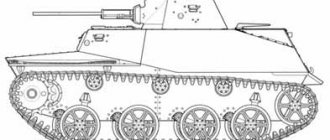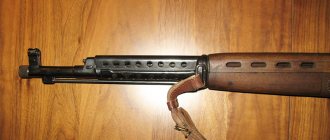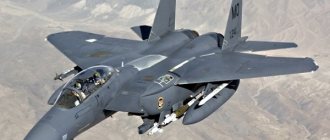History of the creation of the I-250 (MiG-13) fighter
By 1944, it had become definitely clear that the existing models of piston aircraft were, in fact, the limit of what aviation was capable of at this stage of development. In addition, the German Me-262 and He-162 jet fighters were already in mass production, and the Soviet BI-1/BI-2 were successfully tested, achieving impressive results in terms of speed and maneuvering characteristics. In general, one thing was certain - the future belonged to jet aviation.
At the beginning of 1944, the USSR State Defense Committee adopted a resolution on the creation of jet aircraft. Several design bureaus began their development at once.
A.S. Yakovlev, S.A. Lavochkin and P.O. Sukhoi took their best production (piston) aircraft Yak-3, La-7 and Su-6 as a basis, installing an additional liquid-propellant jet engine on them. Tests showed that although there was an increase in speed with the jet engine turned on, it was still too short-lived and insignificant. At the same time, with the auxiliary engine turned off, deterioration in the flight performance of fighters was noted, as well as a significantly increased percentage of accidents.
Drawing of the I-250 (MiG-13) fighter
M.I. Gurevich took a completely different path - instead of trying to cross “snake and snake”, that is, putting a jet engine on an aircraft on which it was not initially even planned to introduce such an innovation, he began developing a completely new fighter, designated I-250 ( product "N") . The lead engineer of the aircraft was A. A. Andreev.
A prototype of the I-250 fighter was built in February 1945, and tests of a prototype of the I-250 fighter were carried out in March-May 1945. The vehicle was tested at various altitudes and operating modes of the power plant, with and without jet thrust. During one of the flights with the jet engine running, the fighter reached a speed of 825 km/h at an altitude of 7800 m. Without turning on the additional engine, the speed at the same altitude did not exceed 677 km/h. In May 1945, while performing another test flight at low altitude and high speed, an accident occurred - the stabilizer collapsed due to overloads. Test pilot A.P. Deev died.
However, during the tests, the design data of the designers were largely confirmed; the combined power plant worked flawlessly. Development and flight operation allowed us to accumulate experience, which turned out to be very useful in the subsequent development of turbojet engines. However, a number of shortcomings were also identified. Eliminating them and modernizing the aircraft took time. Therefore, a small batch of production vehicles was produced only after the end of the war. A total of 28 I-250 fighters were built (including 2 prototypes).
I-250 fighter, side view
The serially built I-250 aircraft (product “N”) received the designation MiG-13 , thus becoming the first jet aircraft of the A.I. Design Bureau. Mikoyan and M.I. Gurevich. They were used in the aviation of the Northern and Baltic fleets until 1950 and were withdrawn from service due to the appearance of MiG-9 and Yak-15 jet fighters with turbojet engines in combat units.
Design of the I-250 (MiG-13) fighter
The I-250 fighter was an all-metal monoplane with a low wing and retractable landing gear in flight. The fuel system consisted of three soft tested tanks: one 420-liter tank was located in the fuselage in front of the cockpit, and two 100-liter tanks were located in the center section.
The aircraft became an interesting “transitional option” in the history of aviation. The I-250 was no longer a purely piston fighter, however, it also did not have a liquid-propellant jet engine (LPRE) similar to those installed on the Yaks and Lavochkins.
Instead, an original design was used: a combined piston/air-jet engine designed by CIAM. The main engine (VK-107A, 1650 hp) drove the tractor propeller - in this the I-250 was no different from other Soviet vehicles of the same period. However, the engine was equipped with a take-off shaft leading to a compressor air-breathing engine (VRDK).
I-250 fighter, the air intake of the jet engine is clearly visible
This engine was located in a tunnel located along the entire length of the fuselage, starting from the air intake and ending with the tail nozzle. The incoming air, after compression in the compressor, was cooled using a water radiator and ended up in the combustion chamber. In the front part it had a block of nozzle chambers for injection and mixing of fuel. The gas channel was closed by an outlet nozzle with adjustable flaps (the designers called this unit a “firebox”). The VRDK compressor was also used to supercharge the piston engine, which increased its altitude.
The power developed by the VK-107 engine during takeoff and during flight without the use of a thruster was entirely transferred to the propeller, and the compressor rotated as if at idle. To shorten the takeoff run and increase the flight speed to maximum, the compressor drive was turned on, and fuel entered the combustion chamber. Gasoline served as fuel for the main engine and for the VRDK. The total power of both engines reached 2800 hp.
The armament of the I-250 fighter consisted of three 20-mm B-20 cannons with 160 rounds of ammunition. One of them was located in the camber of the engine cylinders, two synchronous guns were located symmetrically on the sides of the engine.
The aircraft's armor consisted of an armored backrest and armored glass in front and behind the pilot's seat.
Naval aviation fighter I-250 (MiG-13)
Work on the creation of an experimental fighter with a combined power plant began in accordance with the GKO decree of May 22, 1944.
| I-250 (MiG-13) | |
| Purpose: | Naval fighter |
| Characteristics | |
| Crew: | 1 person |
| Max. ground speed: | 680 km/h |
| Maximum speed at altitude: | 820 km/h |
| Practical flight range: | 790 km |
| Practical ceiling: | 11900 m |
| Dimensions | |
| Length: | 8.19 m |
| Height: | 2.81 m |
| Wingspan: | 9.50 m |
| Wing area: | 15.00 m? |
| Weight | |
| Empty: | 2797 ;kg |
| Max. takeoff: | 3680 kg |
| Power point | |
| engine's type | 1 PD Klimov VK-107R+ VDRK(1) |
| Thrust (power): | 1 x 1650 kgf |
| Armament | |
| Small arms and cannon weapons: | three 20-mm B-20 cannons (100 rounds per gun), combat load - 230 kg |
The first flight prototype of the aircraft, named I-250 , was handed over to factory tests in February 1945.
The combined power plant I-250 consisted of a VK-107A engine with a power of 1650 hp. and the VRDK accelerator, created at CIAM by K.V. Kholshchevnikov. The power developed by the piston engine was transmitted to two consumers at once: the propeller and the VRDK compressor. During takeoff and during flight without the use of a propeller, the main consumer of power was the propeller, and the compressor of the propeller rotates in low gear. To shorten the takeoff run and increase the flight speed to maximum, the second, highest gear of the compressor drive was engaged, and fuel was supplied to the combustion chamber. The aircraft was equipped with a three-blade propeller AB-10P-60 with a diameter of 3.1 m.
The armament consisted of three 20 mm B-20 cannons (100 rounds of ammunition). One cannon fired through the hollow gearbox shaft and two synchronous ones on the sides of the fuselage.
March 3, 1945 The I-250 aircraft made its first flight. However, on July 5, 1945 During the next test flight, the first copy of the I-250 suffered a disaster, in which test pilot A.P. Deev died. Due to the heavy overload, the stabilizer collapsed. The pilot left the plane, but due to the low altitude, the parachute canopy filled too late, not having time to dampen the speed of the pilot's fall.
In May 1945 The second copy of the I-250 fighter entered factory testing. After the disaster of the first prototype, the stabilizer was strengthened, and to increase directional stability at high flight speeds, the keel area was significantly increased.
The maximum speed obtained during testing was 825 km/h, exceeding by 100-150 km/h the speed of piston fighters of that time. Turning on the airborne thruster during takeoff reduced the take-off distance to 400m.
In 1946 8 I-250 aircraft were built, called MiG-13, which were soon sent for military testing. However, given that by this time aircraft with MIG-9 and Yak-15 jet engines had already appeared, at the beginning of 1948 all aircraft were taken out of service.
| Drawings of I-250 (MiG-13) |
Characteristics of I-250
A country:USSRType:FighterYear of issue:1945Crew:1 personEngine:1x VK-107A with a power of 1650 hp. + 1x VRDK with a power of 2800 hp. Maximum speed:825 km/hPractical ceiling:11900 mRange of flight:1818 kmEmpty weight:No informationMaximum take-off weight:3931 kgWingspan:9.5 mLength:8.18 mHeight:No informationWing area:No informationWeapons:3x 20 mm B-20 cannons
Characteristics are given for modification I-250
• Aviation Directory • Aircraft of the same period • Soviet fighters •
Source: compilation based on publicly available information on the Internet
Late. Jet-piston fighter MiG-13 or I-250
Home » Books on the history of aviation » Latecomer. Jet-piston fighter MiG-13 or I-250
Books on aviation history
boroda 05/27/2020 1009
15
in Favoritesin Favoritesfrom Favorites 7
I always thought that after the appearance of the MiG-9 , all work on piston aircraft was curtailed. However, as it turned out, this is not so.
By the mid-forties, the maximum speed of piston fighters reached about 700 km per hour and further increases were difficult to achieve. At the same time, already in 1944, they began to work closely (in the USSR) on the introduction of various types of jet engines. We tried different types and principles of power plants. By that time there had been quite a lot of developments, but the obvious advantage of one of the schemes had not yet been revealed. In particular, the Mikoyan Design Bureau received the task of creating and putting into production a high-speed fighter that reaches a maximum speed of 810 km/h at altitude with the air-propelled jet engine turned on for 15 minutes (when climbing without the air-propellant engine) and 700 km/h without using the air-propellant engine.
The designers were faced with the choice of the most rational layout of the aircraft, which ensured the efficient operation of the combined power plant, as well as the issue of reducing the likelihood of a fire.
In the spring of 1945, flight tests were already underway (in parallel with the Sukhoi Su-5). The “childhood diseases” of the jet unit were treated for quite a long time, and by the summer of that year the plane reached speeds of up to 820 km per hour. Which was 100 km faster than the fastest fighters of that time. Without delay, they took and launched 10 cars into series.
The very idea of building production aircraft of such a transitional type seems strange, but at that time, apparently, they wanted to quickly launch something high-speed, and when working with a piston engine, to obtain the necessary maneuverability and other flight characteristics.
Here the situation on the jet aviation “market” changed dramatically - the war ended, our specialists gained access to captured information on German turbojet engines. All efforts were devoted to new types of aircraft; Mikoyan Design Bureau - for the production of MiG-9 with two captured BMW-003. However, testing of the already obsolete aircraft continued. The documentation does not seem to have survived, but there is information about the transfer of about a dozen 250s to the Navy under the name “MiG-13”. In the same months, Mikoyan received the task of developing the future MiG-15 - and all projects like the 250, etc. were closed or relegated to the background. A certain number of 250s were apparently still in service in the Navy, but most likely as training machines.
Specifications:
- Engine type - one Klimov VK-107R plus VDRK
- Total power, hp 1 x 2560
- Maximum speed, km/h at the ground 680 at an altitude of 820
- Practical range, km 790
- Practical ceiling, m 11900
- Crew, persons 1
- Armament: three 20 mm B-20 cannons
Source - https://zen.yandex.ru/media/satdata_sputnik/mig13-bylo-i-takoe-5ec81665e37e2248960efd83










